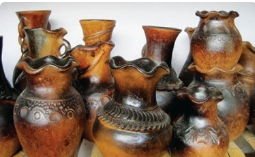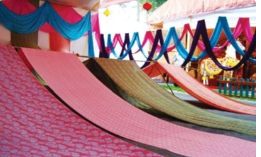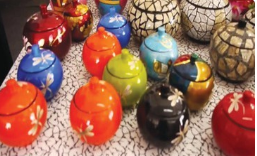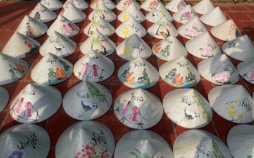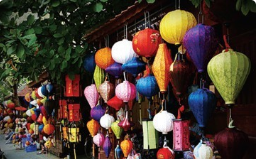Bài học cùng chủ đề
Báo cáo học liệu
Mua học liệu
Mua học liệu:
-
Số dư ví của bạn: 0 coin - 0 Xu
-
Nếu mua học liệu này bạn sẽ bị trừ: 2 coin\Xu
Để nhận Coin\Xu, bạn có thể:

Luyện tập SVIP
Listen and read.
A visit to a traditional craft village
|
... Nick: There are so many pieces of pottery here, Phong. Do your grandparents make all of them? Phong: They can't because we have lots of products. They make some and other people make the rest. Nick: As far as I know, Bat Trang is one of the most famous traditional craft villages of Ha Noi, right? Phong: Right. My grandmother says it's about 700 years old.
|
Mi: Wow! When did your grandparents set up this workshop? Phong: My great-grandparents started it, not my grandparents. Then my grandparents took over the business. All the artisans here are my aunts, uncles, and cousins. Mi: I see. Your village is also a place of interest of Ha Noi, isn't it? Phong: Yes. People come here to buy things for their house. Another attraction is they can make pottery themselves in workshops. Nick: That must be a memorable experience. Phong: In Viet Nam, there are lots of craft villages like Bat Trang. Have you ever been to any others? Mi: I've been to a conical hat making village in Hue! Nick: Cool! This is my first one. Do you think that the various crafts remind people of a specific region? Mi: Sure. It's the reason tourists often choose handicrafts as souvenirs. Phong: Let's go outside and look round the village. |
A visit to a traditional craft village
|
... Nick: There are so many pieces of pottery here, Phong. Do your grandparents make all of them? Phong: They can't because we have lots of products. They make some and other people make the rest. Nick: As far as I know, Bat Trang is one of the most famous traditional craft villages of Ha Noi, right? Phong: Right. My grandmother says it's about 700 years old.
|
Mi: Wow! When did your grandparents set up this workshop? Phong: My great-grandparents started it, not my grandparents. Then my grandparents took over the business. All the artisans here are my aunts, uncles, and cousins. Mi: I see. Your village is also a place of interest of Ha Noi, isn't it? Phong: Yes. People come here to buy things for their house. Another attraction is they can make pottery themselves in workshops. Nick: That must be a memorable experience. Phong: In Viet Nam there are lots of craft villages like Bat Trang. Have you ever been to any others? Mi: I've been to a conical hat making village in Hue! Nick: Cool! This is my first one. Do you think that the various crafts remind people of a specific region? Mi: Sure. It's the reason tourists often choose handicrafts as souvenirs. Phong: Let's go outside and look round the village. |
Read conversation again. Can you find a word/phrase that means:
| 1. a thing which is skilfully made with your hands | |
| 2. start something (a business, an organisation, etc.) | |
| 3. take control of something (a business, an organisation, etc.) | |
| 4. people who do skilled work, making things with their hands | |
| 5. an interesting or enjoyable place to go or thing to do | |
| 6. a particular place | |
| 7. make someone remember or think about something | |
| 8. walk around a place to see what is there |
A visit to a traditional craft village
|
... Nick: There are so many pieces of pottery here, Phong. Do your grandparents make all of them? Phong: They can't because we have lots of products. They make some and other people make the rest. Nick: As far as I know, Bat Trang is one of the most famous traditional craft villages of Ha Noi, right? Phong: Right. My grandmother says it's about 700 years old.
|
Mi: Wow! When did your grandparents set up this workshop? Phong: My great-grandparents started it, not my grandparents. Then my grandparents took over the business. All the artisans here are my aunts, uncles, and cousins. Mi: I see. Your village is also a place of interest of Ha Noi, isn't it? Phong: Yes. People come here to buy things for their house. Another attraction is they can make pottery themselves in workshops. Nick: That must be a memorable experience. Phong: In Viet Nam there are lots of craft villages like Bat Trang. Have you ever been to any others? Mi: I've been to a conical hat making village in Hue! Nick: Cool! This is my first one. Do you think that the various crafts remind people of a specific region? Mi: Sure. It's the reason tourists often choose handicrafts as souvenirs. Phong: Let's go outside and look round the village. |
Read conversation again and answer the following questions.
1. Where are Nick, Mi, and Phong?
2. How old is the village?
3. Who started Phong's family workshop?
A visit to a traditional craft village
|
... Nick: There are so many pieces of pottery here, Phong. Do your grandparents make all of them? Phong: They can't because we have lots of products. They make some and other people make the rest. Nick: As far as I know, Bat Trang is one of the most famous traditional craft villages of Ha Noi, right? Phong: Right. My grandmother says it's about 700 years old.
|
Mi: Wow! When did your grandparents set up this workshop? Phong: My great-grandparents started it, not my grandparents. Then my grandparents took over the business. All the artisans here are my aunts, uncles, and cousins. Mi: I see. Your village is also a place of interest of Ha Noi, isn't it? Phong: Yes. People come here to buy things for their house. Another attraction is they can make pottery themselves in workshops. Nick: That must be a memorable experience. Phong: In Viet Nam there are lots of craft villages like Bat Trang. Have you ever been to any others? Mi: I've been to a conical hat making village in Hue! Nick: Cool! This is my first one. Do you think that the various crafts remind people of a specific region? Mi: Sure. It's the reason tourists often choose handicrafts as souvenirs. Phong: Let's go outside and look round the village. |
Read conversation again and answer the following questions.
1. Why is the village a place of interest in Ha Noi?
2. Where is the craft village that Mi visited?
3. Why do tourists like to buy handicrafts as souvenirs?

Write the name of each traditional handicraft in the box under the picture.
|
|
|
|
|
|
(Kéo thả hoặc click vào để điền)

Write the name of each traditional handicraft in the box under the picture.
|
|
|
|
|
|
(Kéo thả hoặc click vào để điền)
Complete the sentences with the words/phrases in the box to show where in Viet Nam the handicrafts are made. You do not have to use them all.
1. The birthplace of the famous bai tho is Tay Ho village in Hue.
2. If you go to Hoi An on the 15th of each lunar month, you can enjoy the lights of many beautiful .
3. Van Phuc village in Ha Noi produces different types of products such as cloth, scarves, ties, and dresses.
4. On the Tet holiday, many Hanoians go to Dong Ho village to buy folk .
5. products of Bau Truc, such as pots and vases, have the natural colors typical of Champa culture in Ninh Thuan.
6. Going to Non-Nuoc marble village in Da Nang, we're impressed by a wide variety of from Buddha statues to bracelets.
(Kéo thả hoặc click vào để điền)
QUIZ: WHAT IS INTEREST? Work in pairs to do the quiz.
| 1. People go to this area to walk, play, and relax. | |
| 2. It is a place where objects of artistic, cultural, historical, or scientific interest are kept and shown. | |
| 3. People go to this place to see animals. | |
| 4. It is an area of sand, or small stones, beside the sea or a lake. | |
| 5. It is a beautiful and famous place in the countryside. |

Bạn có thể đăng câu hỏi về bài học này ở đây





